Grid Model of Energy Consumption Using Random Forest by Integrating Data on the Nighttime Light, Population, and Urban Impervious Surface (2000–2020) in the Guangdong–Hong Kong–Macau Greater Bay Area
Abstract
1. Introduction
2. Materials and Methods
2.1. Study Area
2.2. Data Sources
2.3. Methods
2.3.1. Random Forest Model
2.3.2. Accuracy Evaluating
2.3.3. Grid Model of Energy Consumption
3. Results
3.1. Results of Model and Accuracy Evaluation
3.2. Spatiotemporal Dynamics of Energy Consumption at the City Scale
3.3. Spatiotemporal Dynamics of Energy Consumption at the Grid Scale
4. Discussion
5. Conclusions
- (1)
- The grid random forest model for estimating metropolitan-level energy consumption shows high accuracy after integrating nighttime light data, population data, and urban impervious surface data in the Guangdong–Hong Kong–Macao Greater Bay Area, with an R2 of more than 0.9783 and a MAPE of less than 9%.
- (2)
- Energy consumption in the study area increased significantly from 2000 to 2020 with a growth rate of about 205%. Guangzhou, Shenzhen, Dongguan, and Huizhou accounted for 72% of the total increase, indicating that these areas had rapid development and high energy consumption.
- (3)
- About 90% of the region’s energy consumption was concentrated in only 22% of the area, indicating a pronounced concentration of energy consumption within the Greater Bay Area. This shows that the urban core areas are the main drivers of energy demand and consumption.
- (4)
- Urban impervious surface data were found to be the most critical factor in predicting energy use (with an importance index of 0.43), indicating the significant impact of urbanization factors, including building density and transportation network completeness, on energy use patterns. This was closely followed by population density data (with an importance index of 0.41), highlighting the role of population distribution in influencing energy demand and consumption. This study shows that areas with a higher population density tend to have higher energy consumption. The importance index of the data on light density was 0.16, which is relatively low. However, there was still a positive correlation between nighttime light brightness and energy consumption.
- (5)
- The method not only provides a robust framework for estimating energy consumption at the city and grid levels with high spatial resolution but also for monitoring the spatiotemporal evolution of energy consumption. This study could serve as a valuable reference for urban planning and energy policy formulation for sustainable development in regions where detailed energy consumption data are not available.
Author Contributions
Funding
Data Availability Statement
Acknowledgments
Conflicts of Interest
References
- Banday, U.J.; Aneja, R. Renewable and non-renewable energy consumption, economic growth and carbon emission in BRICS. Int. J. Energy Sect. Manag. 2020, 14, 248–260. [Google Scholar] [CrossRef]
- Bhuiyan, M.A.; Zhang, Q.; Khare, V.; Mikhaylov, A.; Pinter, G.; Huang, X. Renewable energy consumption and economic growth nexus—A systematic literature review. Front. Environ. Sci. 2022, 10, 878394. [Google Scholar] [CrossRef]
- Sahlian, D.N.; Popa, A.F.; Creţu, R.F. Does the Increase in Renewable Energy Influence GDP Growth? An EU-28 Analysis. Energies 2021, 14, 4762. [Google Scholar] [CrossRef]
- Magazzino, C.; Mele, M.; Schneider, N. A machine learning approach on the relationship among solar and wind energy production, coal consumption, GDP, and CO2 emissions. Renew. Energy 2021, 167, 99–115. [Google Scholar] [CrossRef]
- Zhao, J.C.; Liu, Q.Q. Examining the driving factors of urban residential carbon intensity using the LMDI method: Evidence from China’s county-level cities. Int. J. Environ. Res. Public Health 2021, 18, 3929. [Google Scholar] [CrossRef] [PubMed]
- Wang, S.; Li, C.; Zhou, H. Impact of China’s economic growth and energy consumption structure on atmospheric pollutants: Based on a panel threshold model. J. Clean. Prod. 2019, 236, 117694. [Google Scholar] [CrossRef]
- Zheng, W.; Walsh, P.P. Economic growth, urbanization and energy consumption: A provincial level analysis of China. Energy Econ. 2019, 80, 153–162. [Google Scholar] [CrossRef]
- Guo, R.; Yuan, Y. Different types of environmental regulations and heterogeneous influence on energy efficiency in the industrial sector: Evidence from Chinese provincial data. Energy Policy 2020, 145, 111747. [Google Scholar] [CrossRef]
- Li, Y.; Chiu, Y.H.; Lu, L.C.; Chiu, C.R. Evaluation of energy efficiency and air pollutant emissions in Chinese provinces. Energy Effic. 2018, 12, 963–977. [Google Scholar] [CrossRef]
- Bennett, M.M.; Smith, L.C. Advances in using multitemporal nighttime lights satellite imagery to detect, estimate, and monitor socioeconomic dynamics. Remote Sens. Environ. 2017, 192, 176–197. [Google Scholar] [CrossRef]
- McCord, G.C.; Rodriguez-Heredia, M. Nightlights and Subnational Economic Activity: Estimating Departmental GDP in Paraguay. Remote Sens. 2022, 14, 1150. [Google Scholar] [CrossRef]
- Yang, C.; Yu, B.; Chen, Z.; Song, W.; Zhou, Y.; Li, X.; Wu, J. A Spatial-Socioeconomic Urban Development Status Curve from NPP-VIIRS Nighttime Light Data. Remote Sens. 2019, 11, 2398. [Google Scholar] [CrossRef]
- Xie, Y.; Weng, Q. World energy consumption pattern as revealed by DMSP-OLS nighttime light imagery. Mapp. Sci. Remote Sens. 2016, 53, 265–282. [Google Scholar] [CrossRef]
- Welch, R. Monitoring urban population and energy utilization patterns from satellite data. Remote Sens. Environ. 1980, 9, 1–9. [Google Scholar] [CrossRef]
- Amaral, S.; Cmara, G.; Monteiro, A.M.V.; Quintanilha, J.A.; Elvidge, C.D. Estimating population and energy consumption in Brazilian Amazonia using DMSP night–time satellite data. Comput. Environ. Urban Syst. 2005, 29, 179–195. [Google Scholar] [CrossRef]
- Letu, H.; Hara, M.; Yagi, H.; Tana, G.; Nishio, F. Estimating the energy consumption with nighttime city light from the DMSP/OLS imagery. In Proceedings of the 2009 Joint Urban Remote Sensing Event, Shanghai, China, 20–22 May 2009; pp. 1364–1370. [Google Scholar]
- Wu, J.S.; Niu, Y.; Peng, J.; Wang, Z.; Huang, X. Dynamics of Energy Consumption in China’s Prefecture-Level Cities from 1995 to 2009 Based on DMSP/OLS Nighttime Light Data. Geogr. Res. 2014, 33, 625–634. [Google Scholar]
- Bai, C.C. Study on Spatial and Temporal Dynamic Evolution of Energy Consumption in Prefecture-Level City of China Based on Multi-Source Remote Sensing Data. Master’s Thesis, Nanchang University, Nanchang, China, 2016. [Google Scholar]
- Xiao, H.W.; Ma, Z.Y.; Mi, Z.; Kelsey, J.; Zheng, J.; Yin, W.; Yan, M. Spatio–temporal simulation of energy consumption in China’s provinces based on satellite night–time light data. Appl. Energy 2018, 231, 1070–1078. [Google Scholar] [CrossRef]
- Tian, L. Study on Spatio-Temporal Dynamic and Driving Forces of Energy Consumption in China Based on Nighttime Light Data. Master’s Thesis, East China Normal University, Shanghai, China, 2019. [Google Scholar]
- Ou, J.; Liu, X.; Li, X.; Shi, X. Mapping Global Fossil Fuel Combustion CO2 Emissions at High Resolution by Integrating Nightlight, Population Density, and Traffic Network Data. IEEE J. Sel. Top. Appl. Earth Obs. Remote Sens. 2016, 9, 1674–1684. [Google Scholar] [CrossRef]
- Zhao, N.; Liu, Y.; Cao, G.; Samson, E.L.; Zhang, J. Forecasting China’s GDP at the pixel level using nighttime lights time series and population images. GISci. Remote Sens. 2017, 54, 407–425. [Google Scholar] [CrossRef]
- Sun, J.; Di, L.P.; Sun, Z.; Wang, J.; Wu, Y. Estimation of GDP using deep learning with NPP-VIIRS imagery and land cover data at the county level in CONUS. IEEE J. Sel. Top. Appl. Earth Obs. Remote Sens. 2020, 13, 1400–1415. [Google Scholar] [CrossRef]
- Keola, S.; Andersson, M.; Hall, O. Monitoring economic development from space: Using nighttime light and land cover data to measure economic growth. World Dev. 2015, 66, 322–334. [Google Scholar] [CrossRef]
- Chen, Q.; Ye, T.T.; Zhao, N.; Ding, M.; Ouyang, Z.; Jia, P.; Yue, W.; Yang, X. Mapping China’s regional economic activity by integrating points-of-interest and remote sensing data with random forest. Urban Anal. City Sci. 2020, 48, 1–19. [Google Scholar] [CrossRef]
- The State Council of China. Outline Development Plan for the Guangdong-Hong Kong-Macao Greater Bay Area; The State Council of China: Beijing, China, 2019. [Google Scholar]
- Chen, Z.; Yu, B.; Yang, C.; Zhou, Y.; Yao, S.; Qian, X.; Wang, C.; Wu, B.; Wu, J. An Extended Time Series (2000–2018) of Global NPP-VIIRS-Like Nighttime Light Data from a Cross-Sensor Calibration. Earth Syst. Sci. Data 2021, 13, 889–906. [Google Scholar] [CrossRef]
- Bai, Z.Q.; Wang, J.L.; Yang, F. Research progress in spatialization of population data. Prog. Geogr. 2013, 32, 1692–1702. [Google Scholar]
- Bright, E.; Coleman, P.; Dobson, J.E. LandScan: A global population database for estimating populations at risk. Photogramm. Eng. Remote Sens. 2000, 66, 849–858. [Google Scholar]
- Yang, J.; Huang, X. The 30 m annual land cover dataset and its dynamics in China from 1990 to 2019. Earth Syst. Sci. Data 2021, 13, 3907–3925. [Google Scholar] [CrossRef]
- Breiman, L. Random forests. Mach. Learn. 2001, 45, 5–32. [Google Scholar] [CrossRef]
- Moon, J.; Kim, Y.; Son, M.; Hwang, E. Hybrid short-term load forecasting scheme using random forest and multilayer perceptron. Energies 2018, 11, 3283. [Google Scholar] [CrossRef]
- Sun, Z.; Zhao, Y.; Dong, Y.; Cao, X.; Sun, H. Hybrid model with secondary decomposition, random forest algorithm, clustering analysis and long short memory network principal computing for short-term wind power forecasting on multiple scales. Energy 2021, 221, 119848. [Google Scholar] [CrossRef]
- Ye, T.; Zhao, N.; Yang, X.; Ouyang, Z.; Liu, X.; Chen, Q.; Hu, K.; Yue, W.; Qi, J.; Li, Z.; et al. Improved population mapping for China using remotely sensed and points-of-interest data within a random forests model. Sci. Total Environ. 2019, 658, 936–946. [Google Scholar] [CrossRef] [PubMed]
- Iannace, G.; Ciaburro, G.; Trematerra, A. A wind turbine noise prediction using random forest regression. Machines 2019, 7, 69. [Google Scholar] [CrossRef]
- Li, Z.N.; Ye, A.Z. Advanced Econometrics, 1st ed.; Tsinghua University Press: Beijing, China, 2000. [Google Scholar]
- Lewis, C.D. Industrial and Business Forecasting Method, 1st ed.; Butter-Worth Heinemann Press: London, UK, 1982. [Google Scholar]
- Jia, J.P. Fundamentals of Statistics, 1st ed.; Renmin University of China Press: Beijing, China, 2004. [Google Scholar]
- Xiong, P.P.; Dang, Y.G.; Yao, T.X.; Wang, Z.X. Optimal modeling and forecasting of the energy consumption and production in China. Energy 2014, 77, 623–634. [Google Scholar] [CrossRef]
- Gokhan, A. Modeling of energy consumption based on economic and demographic factors The case of Turkey with projections. Renew. Sustain. Energy Rev. 2014, 35, 382–389. [Google Scholar]
- Kummu, M.; Taka, M.; Guillaume, J.H.A. Gridded global datasets for Gross Domestic Product and Human Development Index over 1990–2015. Sci. Data 2018, 5, 180004. [Google Scholar] [CrossRef] [PubMed]
- Balk, D.; Yetman, G. The Global Distribution of Population: Evaluating the Gains in Resolution Refinement; Center for International Earth Science Information Network (CIESIN), Columbia University: New York, NY, USA, 2004. [Google Scholar]
- Balk, D.L.; Deichmann, U.; Yetman, G.; Pozzi, F.; Hay, S.I.; Nelson, A. Determining global population distribution: Methods, applications and data. Adv. Parasitol. 2006, 62, 119–156. [Google Scholar] [PubMed]
- Lei, Y.X. A Study on PM2.5 Prediction Model in Dalian; Dalian Maritime University: Dalian, China, 2021. [Google Scholar]
- Xie, H.L.; He, Y.F.; Zou, J.L.; WU, Q. Spatial–temporal difference analysis of cultivated land use intensity based on emergy in Poyang Lake Eco-economic Zone. J. Geogr. Sci. 2016, 26, 1412–1430. [Google Scholar] [CrossRef]
- Shi, K.; Chen, Y.; Yu, B.; Xu, T.; Chen, Z.; Liu, R.; Li, L.; Wu, J. Modeling spatiotemporal CO2 (carbon dioxide) emission dynamics in China from DMSP-OLS nighttime stable light data using panel data analysis. Appl. Energy 2016, 168, 523–533. [Google Scholar] [CrossRef]
- Yue, Y.; Tian, L.; Yue, Q.; Wang, Z. Spatiotemporal variations in energy consumption and their infuencing factors in China based on the integration of the DMSP-OLS and NPP-VIIRS nighttime light datasets. Remote Sens. 2020, 12, 1151. [Google Scholar] [CrossRef]
- Chen, J.D.; Liu, J.L. City- and county-level spatiotemporal energy consumption and efficiency datasets for China from 1997 to 2017. Sci. Data 2022, 9, 101. [Google Scholar] [CrossRef] [PubMed]
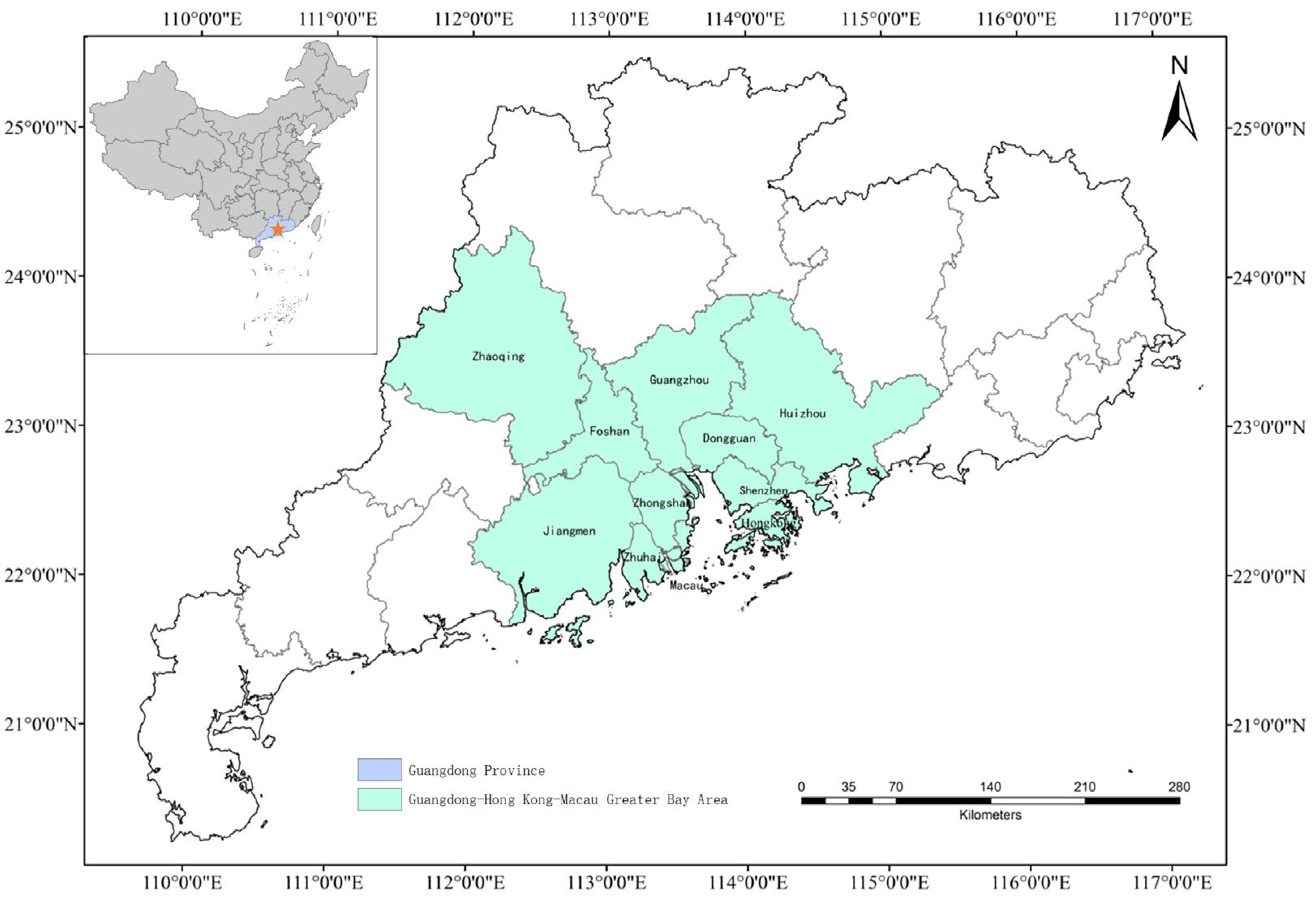
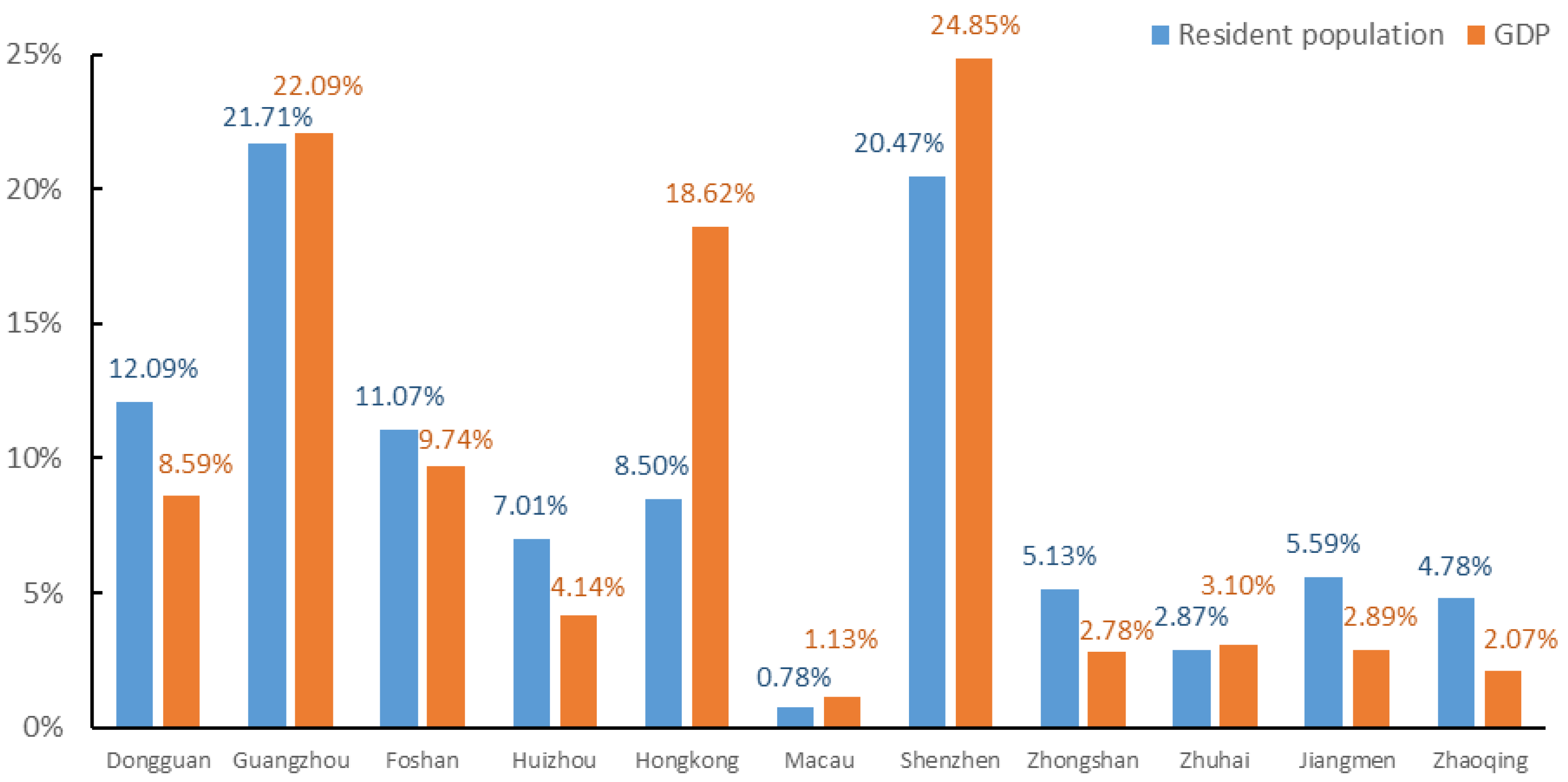

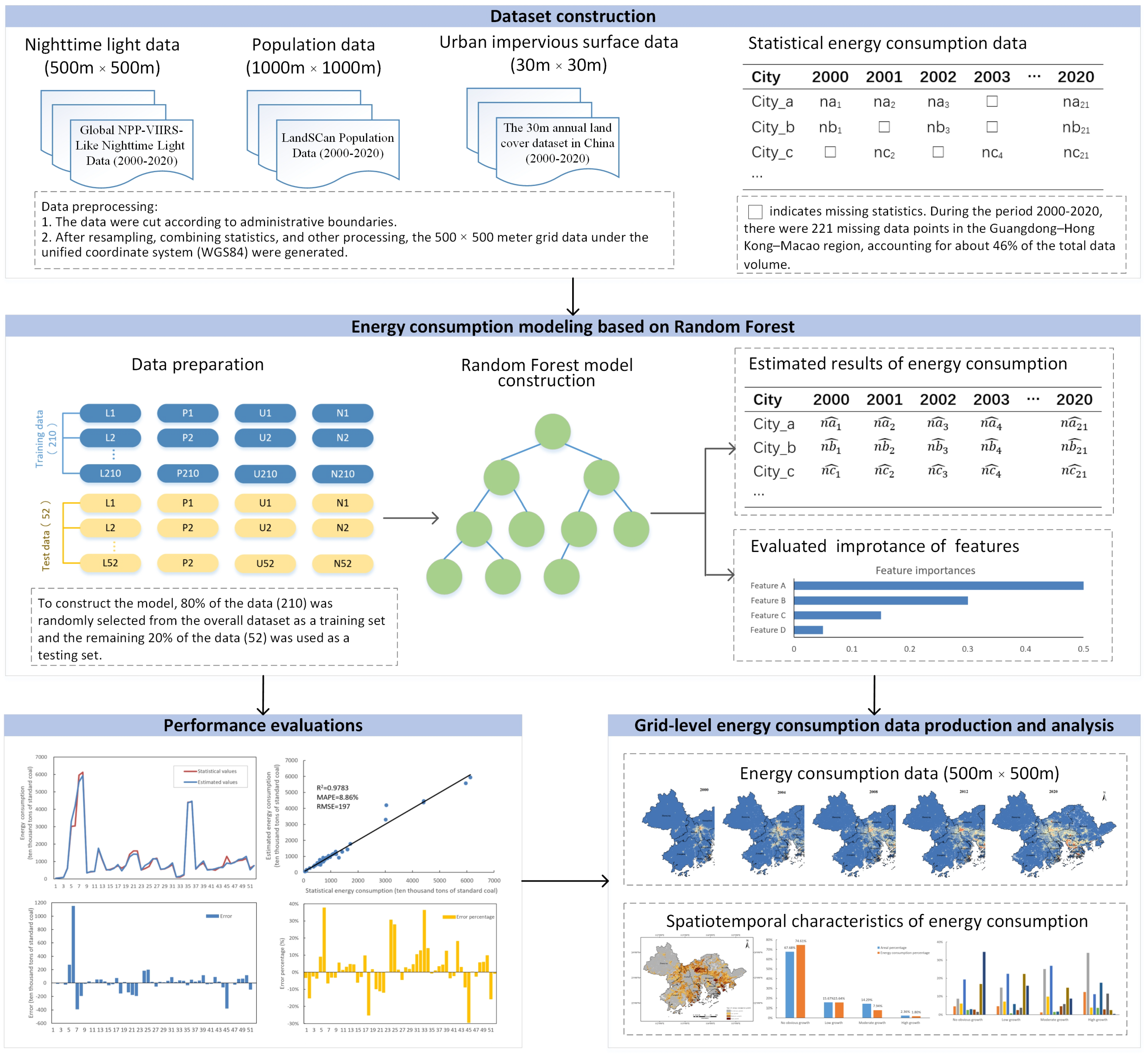
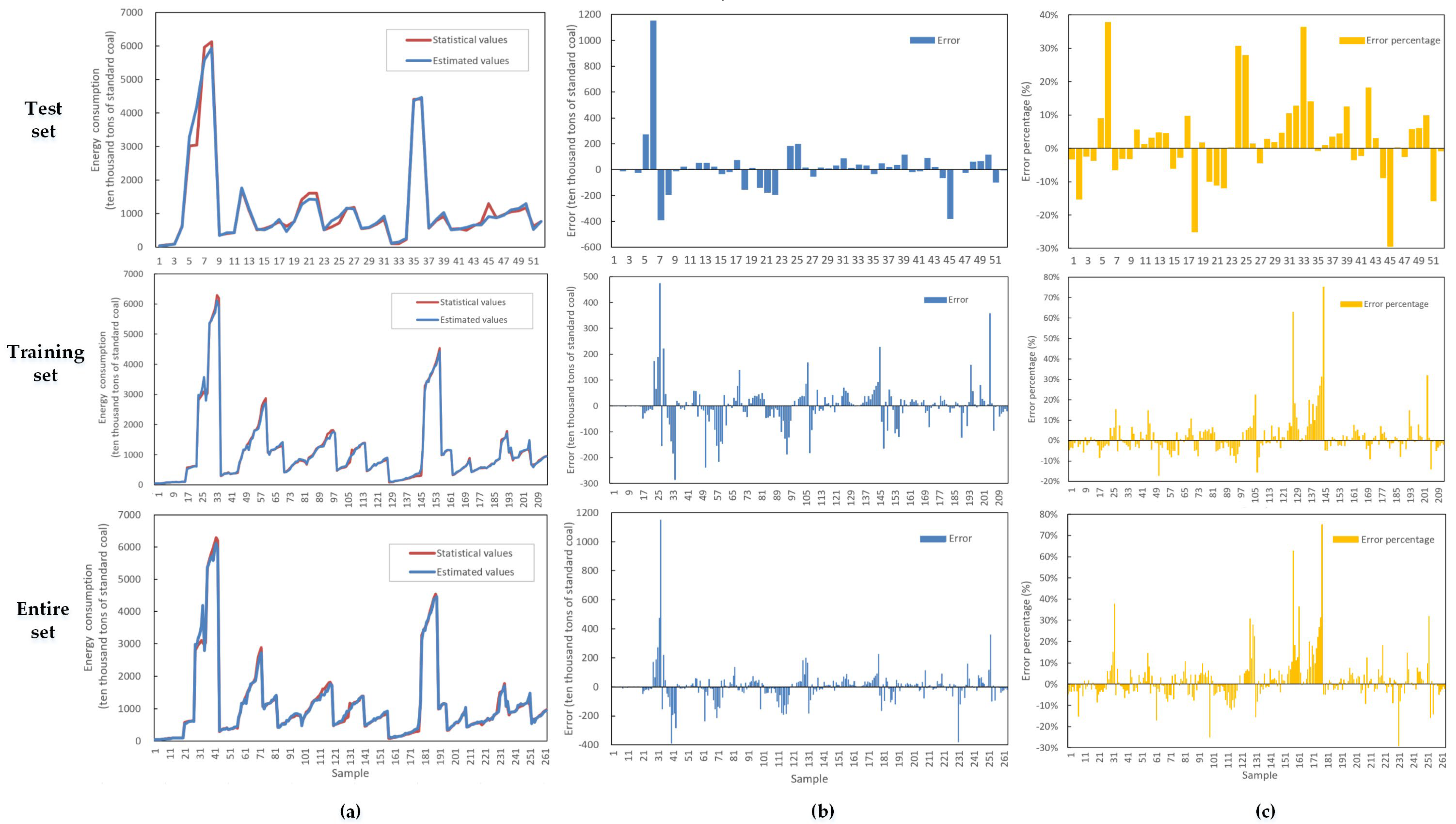


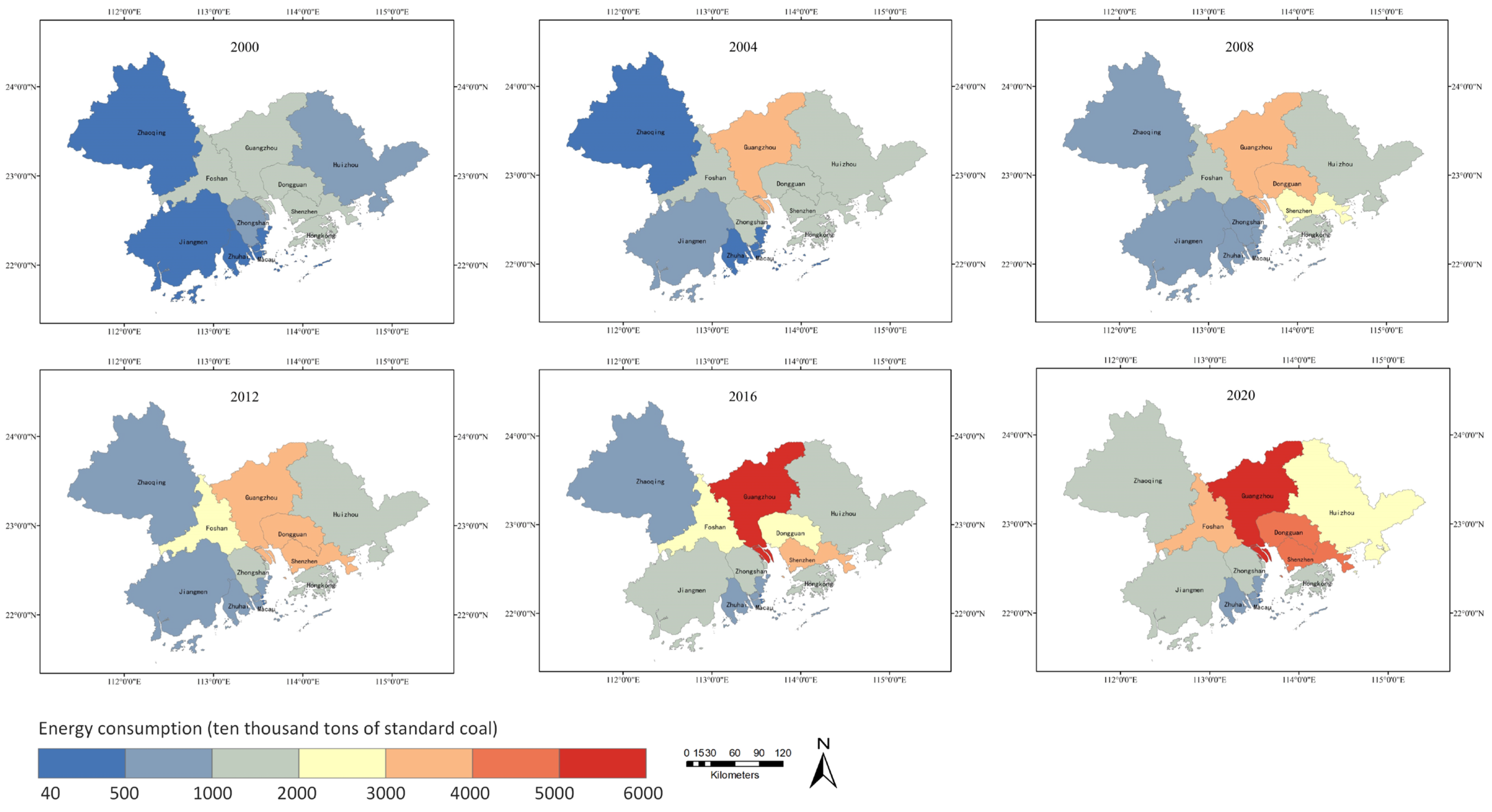

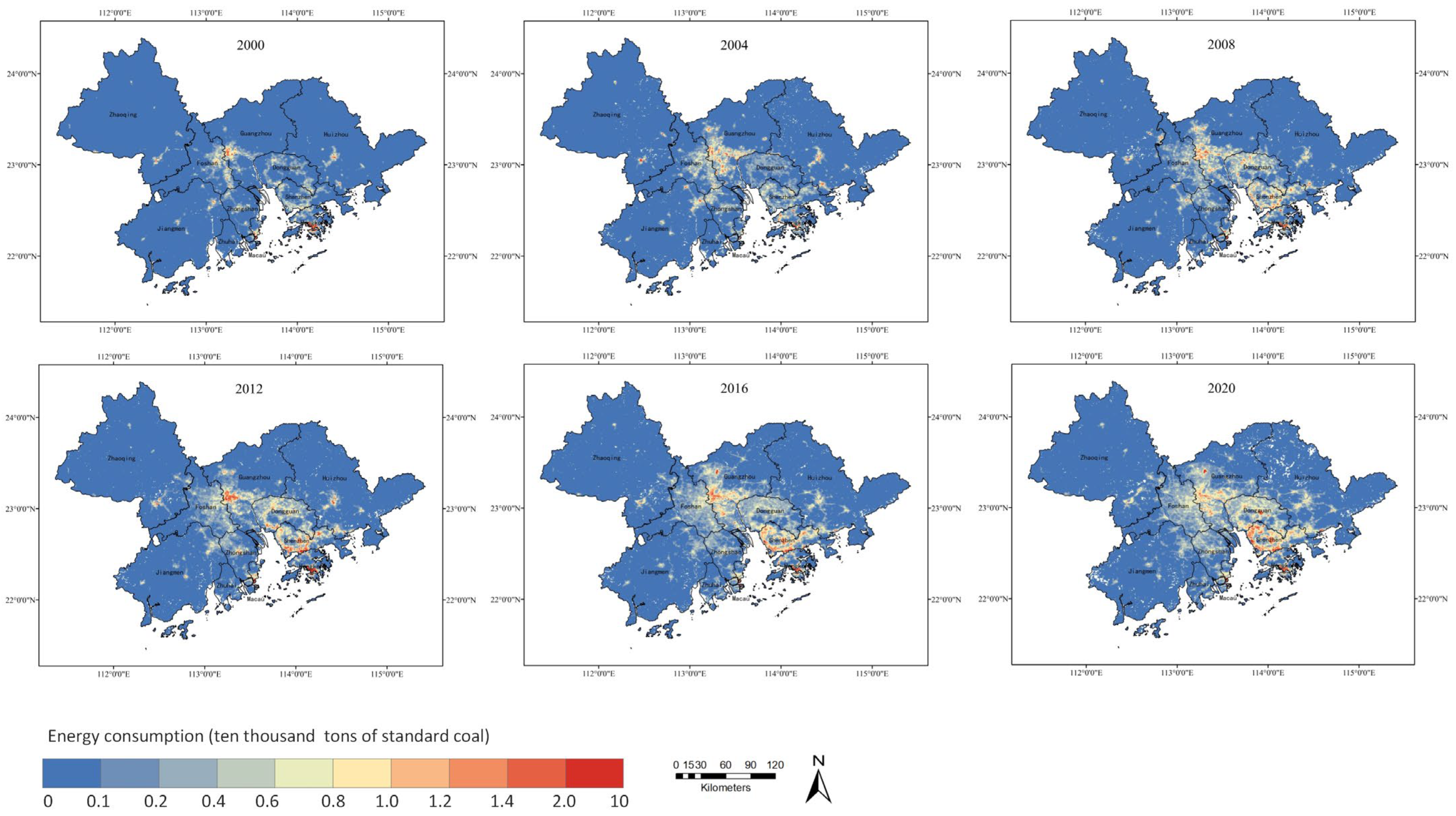
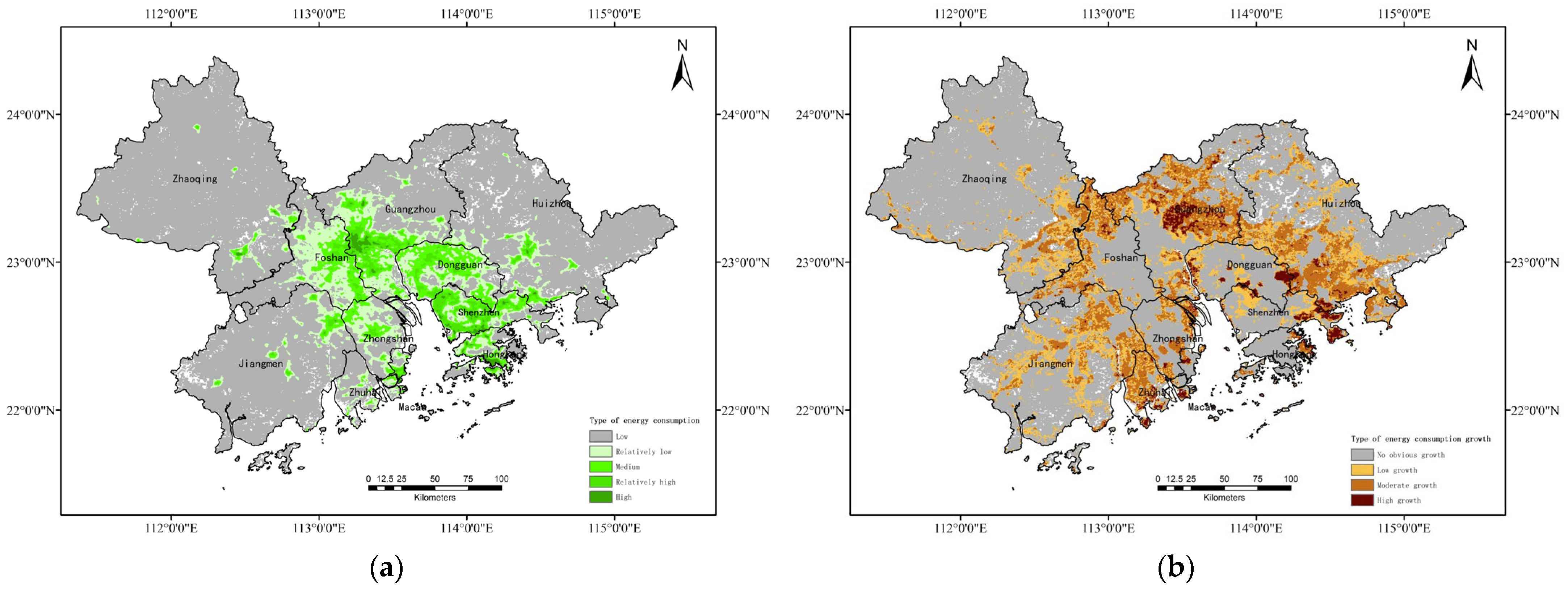


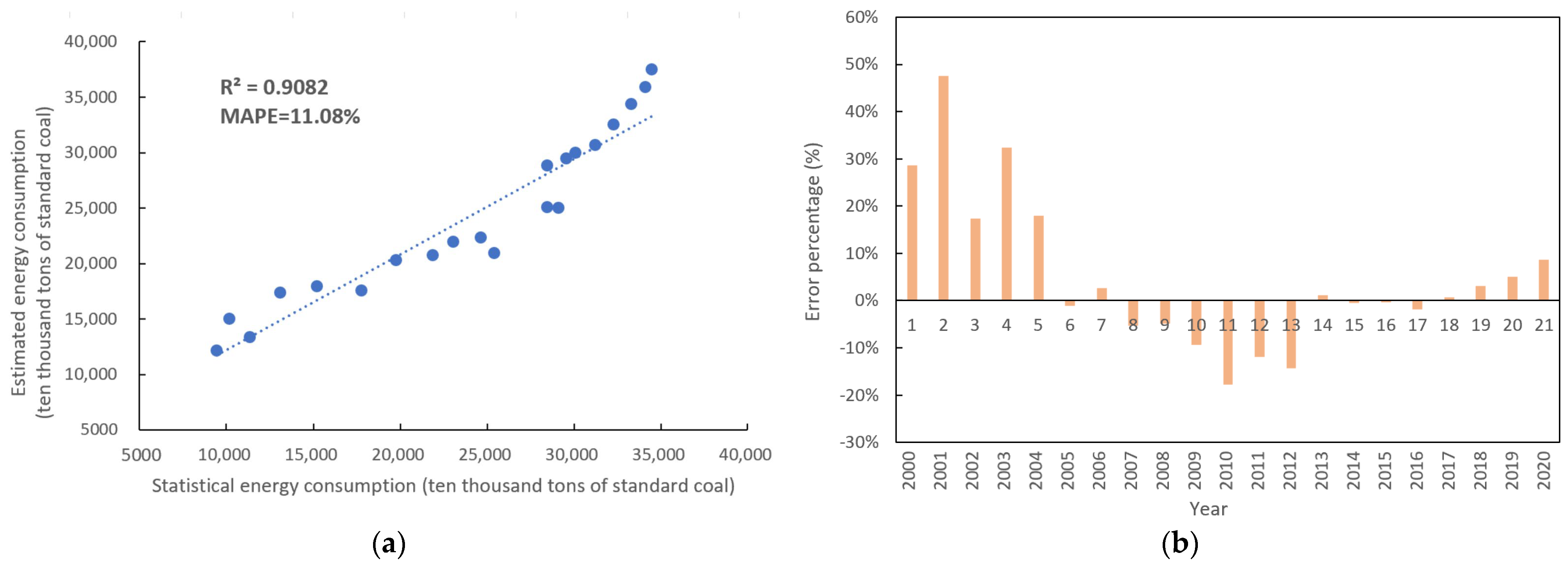
| Data | Data Description | Year | Source |
|---|---|---|---|
| Nighttime light data | spatial resolution: 500 m × 500 m temporal resolution: annual data unit: DN | 2000–2020 | Yangtze River Delta Science Data Center, National Earth System Science Data Center, National Science & Technology Infrastructure of China, “Global 500-Meter Resolution ‘NPP-VIIRS-like’ Nighttime Light Dataset” http://www.geodata.cn (accessed on 20 May 2023) |
| Population data | spatial resolution: 1000 m × 1000 m temporal resolution: annual data unit: population per grid cell | 2000–2020 | Landscan Global Population database https://landscan.ornl.gov (accessed on 15 February 2023) |
| Urban impervious surface data | spatial resolution: 30 m × 30 m temporal resolution: annual data unit: square meter | 2000–2020 | National Cryosphere Desert Data Ceter, “China’s 30-m Annual Land Cover Dataset for the Years 1990 to 2022” http://www.ncdc.ac.cn (accessed on 29 August 2023) |
| Energy consumption data | annual total energy consumption data of cities in Guangdong–Hong Kong–Macau | 2000–2020 | Statistical Yearbooks, National Economic and Social Development Statistical Bulletins of cities in Guangdong–Hong Kong–Macao, and China Energy Statistical Yearbook |
| Administrative boundaries | shape files of cities in Guangdong–Hong Kong–Macau | 2017 | National Geomatics Center of China |
Disclaimer/Publisher’s Note: The statements, opinions and data contained in all publications are solely those of the individual author(s) and contributor(s) and not of MDPI and/or the editor(s). MDPI and/or the editor(s) disclaim responsibility for any injury to people or property resulting from any ideas, methods, instructions or products referred to in the content. |
© 2024 by the authors. Licensee MDPI, Basel, Switzerland. This article is an open access article distributed under the terms and conditions of the Creative Commons Attribution (CC BY) license (https://creativecommons.org/licenses/by/4.0/).
Share and Cite
Lei, Y.; Xu, C.; Wang, Y.; Liu, X. Grid Model of Energy Consumption Using Random Forest by Integrating Data on the Nighttime Light, Population, and Urban Impervious Surface (2000–2020) in the Guangdong–Hong Kong–Macau Greater Bay Area. Energies 2024, 17, 2518. https://doi.org/10.3390/en17112518
Lei Y, Xu C, Wang Y, Liu X. Grid Model of Energy Consumption Using Random Forest by Integrating Data on the Nighttime Light, Population, and Urban Impervious Surface (2000–2020) in the Guangdong–Hong Kong–Macau Greater Bay Area. Energies. 2024; 17(11):2518. https://doi.org/10.3390/en17112518
Chicago/Turabian StyleLei, Yanfei, Chao Xu, Yunpeng Wang, and Xulong Liu. 2024. "Grid Model of Energy Consumption Using Random Forest by Integrating Data on the Nighttime Light, Population, and Urban Impervious Surface (2000–2020) in the Guangdong–Hong Kong–Macau Greater Bay Area" Energies 17, no. 11: 2518. https://doi.org/10.3390/en17112518
APA StyleLei, Y., Xu, C., Wang, Y., & Liu, X. (2024). Grid Model of Energy Consumption Using Random Forest by Integrating Data on the Nighttime Light, Population, and Urban Impervious Surface (2000–2020) in the Guangdong–Hong Kong–Macau Greater Bay Area. Energies, 17(11), 2518. https://doi.org/10.3390/en17112518






